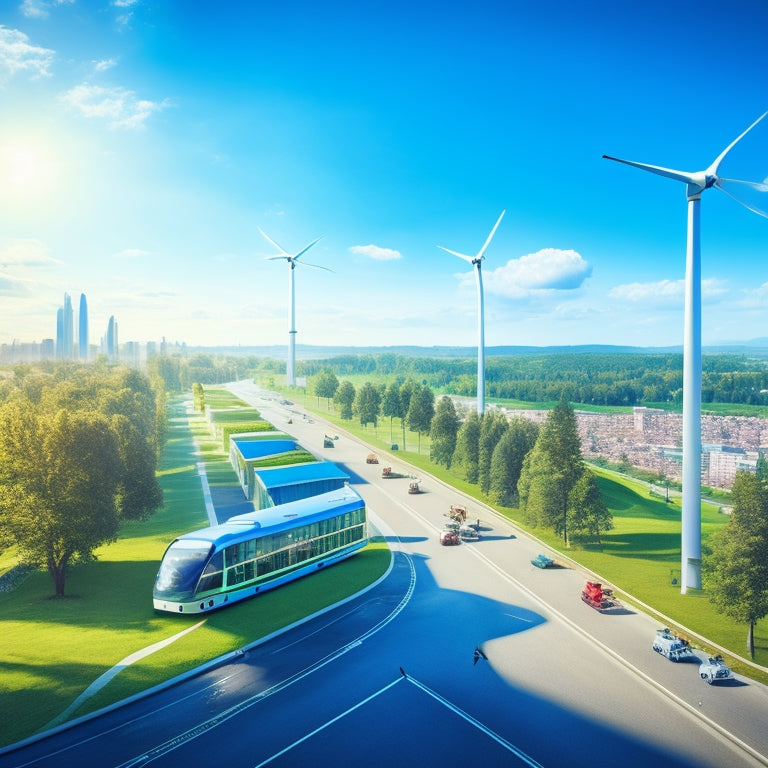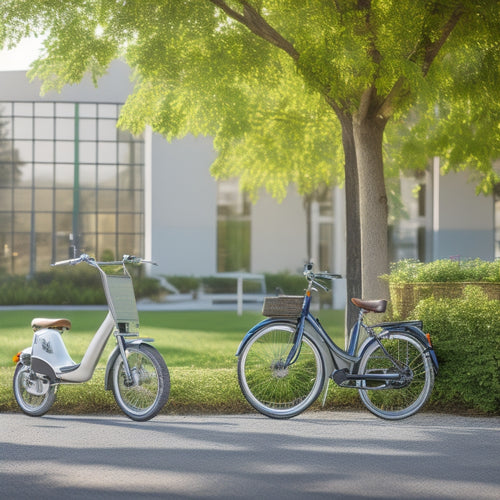
Designing Urban Transportation Systems for a Greener Future
Share
You're tasked with designing urban transportation systems that prioritize sustainability, which involves integrating electric vehicles, green public transit, and smart traffic management to reduce emissions and create a healthier environment. To start, develop essential electric vehicle infrastructure, incorporating Vehicle to Grid technology and energy storage systems. Integrate EV-friendly zoning regulations and dedicated EV lanes, then prioritize efficiency, reliability, and sustainability in green public transit systems. As you design for a greener future, you'll uncover innovative strategies to transform urban mobility, and the path forward will reveal itself, leading you to even more groundbreaking solutions.
Key Takeaways
• Develop essential electric vehicle infrastructure, including Vehicle to Grid technology and energy storage systems, to mitigate strain on the grid.
• Incorporate sustainable urban mobility solutions, such as green public transit options and eco-friendly infrastructure, to reduce emissions.
• Design bike-friendly road networks with dedicated lanes, smart traffic management, and real-time information systems to promote eco-friendly transportation.
• Implement smart traffic management systems with IoT sensors, cameras, and intelligent signage to optimize traffic flow and reduce congestion.
• Create green spaces with urban forestry, park connectivity, and eco-friendly infrastructure to mitigate the urban heat island effect and promote sustainable transportation.
Electric Vehicle Charging Infrastructure
As you design urban transportation systems for the future, integrating an extensive network of electric vehicle charging infrastructure is vital to support the widespread adoption of electric vehicles and reduce greenhouse gas emissions.
You'll need to prioritize charging station design that's efficient, accessible, and scalable. This means incorporating Vehicle to Grid (V2G) technology, which enables electric vehicles to supply energy back to the grid when not in use. This two-way flow of energy can stabilize the grid, reduce strain during peak hours, and even generate revenue for vehicle owners.
When designing charging stations, consider high-power charging corridors along highways, urban hubs with fast-charging capabilities, and destination charging points at popular locations.
Smart charging systems that optimize energy distribution, minimize strain on the grid, and provide real-time monitoring will be essential. By integrating these elements, you'll create a seamless, efficient, and sustainable electric vehicle ecosystem that supports the transportation needs of tomorrow.
Urban Planning for EV Integration
Design urban landscapes that prioritize electric vehicle integration by incorporating EV-friendly zoning regulations, dedicated EV lanes, and strategically located charging infrastructure to facilitate a smooth shift to sustainable transportation.
As you plan for the future of urban mobility, consider the impact of land use on EV adoption. By rezoning areas to accommodate EV-centric development, you can create hubs for sustainable transportation. This might involve designating specific zones for EV-friendly businesses, such as charging stations, EV-sharing services, or EV-friendly parking garages.
Additionally, you can optimize land use by incorporating green spaces, pedestrian-friendly areas, and mixed-use developments that reduce the need for personal vehicles. Effective zoning regulations can also encourage developers to incorporate EV-friendly features into new construction projects.
Green Transportation Network Design
As you design a green transportation network, you'll need to prioritize electric vehicle infrastructure, ensuring a smooth shift to sustainable energy.
You'll also want to incorporate bike-friendly road networks, promoting a healthier, more environmentally conscious commute.
Electric Vehicle Infrastructure
Developing an essential electric vehicle infrastructure is crucial to supporting the widespread adoption of green transportation, and you'll need to take into account everything from charging station placement to grid capacity.
As you design this infrastructure, you'll want to take into consideration the role of Vehicle to Grid (V2G) technology, which enables electric vehicles to feed energy back into the grid when not in use. This can help stabilize the grid and even provide a new revenue stream for vehicle owners.
Energy Storage systems will also play a significant role, as they'll help to mitigate the strain of increased energy demand from widespread EV adoption. By strategically placing charging stations and energy storage systems, you can create a resilient and efficient electric vehicle infrastructure that supports the growth of green transportation.
With careful planning, you can create a seamless and sustainable transportation network that benefits both users and the environment.
Bike-Friendly Road Networks
You'll need to rethink traditional road networks to prioritize bike-friendly infrastructure, integrating dedicated bike lanes, smart traffic management, and intelligent signage to create a seamless and safe cycling experience. This innovative approach will redefine urban transportation, encouraging more people to opt for cycling as a primary mode of transportation.
By designing bike lanes with physical barriers, dedicated traffic signals, and smart sensors, you'll guarantee a smooth and efficient ride. Cycling infrastructure will be elevated by incorporating real-time information systems, providing cyclists with crucial data on traffic flow, road conditions, and parking availability. This data-driven approach will optimize routes, reduce congestion, and minimize accidents.
As you design bike-friendly road networks, consider the importance of accessibility, connectivity, and sustainability. With intelligent transportation systems, you'll create a harmonious coexistence between cyclists, pedestrians, and motorists, paving the way for a greener, healthier, and more livable urban environment.
Green Space Integration
By incorporating verdant corridors and eco-friendly infrastructure, urban planners can create a symbiotic relationship between transportation systems and natural environments, fostering a healthier, more resilient urban ecosystem.
As you design green transportation networks, consider the following strategies to maximize the benefits of green space integration:
-
Urban Forestry: Incorporate tree-lined streets and green corridors to mitigate the urban heat island effect, reduce air pollution, and enhance biodiversity.
-
Park Connectivity: Design transportation systems that prioritize park connectivity, ensuring seamless access to green spaces and promoting a healthier, more active population.
-
Eco-Friendly Infrastructure: Implement sustainable materials and green infrastructure, such as green roofs, rain gardens, and permeable pavements, to minimize environmental impact.
- Multimodal Transportation Hubs: Create transportation hubs that integrate green spaces, pedestrian-friendly zones, and eco-friendly transportation options, encouraging a shift towards sustainable mobility.
Sustainable Urban Mobility Solutions
As you design sustainable urban mobility solutions, you'll need to take into account the infrastructure required to support electric vehicles. The development of green public transit options that reduce emissions is also crucial. Additionally, the implementation of smart traffic management systems that optimize traffic flow and reduce congestion is essential.
These solutions will play a vital role in reducing urban transportation's environmental impact. By integrating these components, you'll create a more efficient, eco-friendly transportation network that benefits both citizens and the environment.
Electric Vehicle Infrastructure
Cities must integrate extensive electric vehicle (EV) infrastructure into their urban transportation systems to support widespread adoption and achieve sustainable mobility solutions.
As you design and implement EV infrastructure, consider the following key components:
-
Vehicle to Grid (V2G) Technology: Enables EVs to act as energy storage units, feeding electricity back into the grid when not in use, and providing a potential revenue stream for EV owners.
-
High-Power Charging Corridors: Strategically located along highways and in urban areas, these high-power charging stations can refill EV batteries to 80% in under 30 minutes.
-
Rural Electrification: Extending EV infrastructure to rural areas, where access to charging stations is often limited, will be essential in promoting widespread adoption.
- Smart Charging Systems: These advanced systems optimize charging times based on energy demand, reducing strain on the grid and enabling more efficient energy distribution.
Green Public Transit Options
You'll need to integrate green public transit options into your urban transportation system to reduce emissions and achieve sustainable mobility. This involves investing in eco-friendly public transit systems that prioritize efficiency, reliability, and sustainability.
One effective strategy is to develop Bus Rapid Transit (BRT) systems, which offer high-capacity, efficient, and cost-effective transportation solutions. By designing dedicated bus lanes and optimizing routes, you can reduce travel times, increase ridership, and decrease emissions.
To further enhance the efficiency of your public transit system, consider adopting a Transit Oriented Development (TOD) approach. This involves designing compact, walkable, and mixed-use developments around public transit hubs, reducing the need for personal vehicles and promoting a more sustainable lifestyle.
Smart Traffic Management
By leveraging advanced technologies, including real-time data analytics and IoT sensors, urban planners can optimize traffic flow and reduce congestion, paving the way for sustainable urban mobility solutions.
As you navigate the urban landscape, you'll notice that smart traffic management is essential in reducing travel times, lowering emissions, and improving air quality.
Here are some ways smart traffic management can make a difference:
-
Real-time traffic monitoring: With IoT sensors and cameras, you can track traffic patterns in real-time, identifying areas of congestion and optimizing traffic signal timing to reduce congestion.
-
Route optimization: By analyzing traffic patterns, you can optimize routes for public transit, ride-sharing, and other transportation modes, reducing travel times and emissions.
-
Intelligent traffic signals: Smart traffic signals can adjust their timing in real-time to optimize traffic flow, reducing congestion and emissions.
- Dynamic lane management: By converting existing lanes into dynamic lanes, you can optimize traffic flow, reduce congestion, and increase road capacity.
Electric Vehicle Fleet Management
As urban transportation systems shift towards sustainability, managing electric vehicle fleets efficiently becomes essential, with your fleet management strategy playing a pivotal role in minimizing downtime and optimizing resource allocation.
You'll need to prioritize Vehicle Maintenance to guarantee your electric vehicles (EVs) are always in top condition. This involves implementing proactive maintenance schedules, monitoring battery health, and performing software updates. By doing so, you'll reduce the likelihood of unexpected breakdowns and extend the lifespan of your EVs.
To optimize your fleet, you'll need to analyze data on vehicle performance, driver behavior, and route optimization. This will enable you to identify areas of improvement, adjust your routes, and allocate resources more efficiently. Fleet Optimization is key to reducing operational costs, decreasing emissions, and enhancing the overall passenger experience.
Urban Air Quality Improvement Strategies
Optimizing electric vehicle fleets is only half the battle - the true test of a sustainable urban transportation system lies in mitigating the environmental impact of congestion, and that starts with implementing effective Urban Air Quality Improvement Strategies that can drastically reduce emissions and pollutants. As you design your urban transportation system, you'll need to prioritize air quality improvement strategies that can make a tangible impact.
Here are four key strategies to contemplate:
-
Air pollution monitoring: Implementing real-time air quality monitoring systems can help identify areas of high pollution, allowing you to target emission reduction efforts more effectively.
-
Emission reduction targets: Setting ambitious yet achievable emission reduction targets can help guide your urban transportation system's development and make sure you're on track to meet your sustainability goals.
-
Electrification of public transportation: Shifting public transportation fleets to electric vehicles can greatly reduce emissions and pollutants, improving overall air quality.
- Smart traffic management: Implementing intelligent traffic management systems can help decrease congestion, reducing emissions and pollutants from idling vehicles.
Electric Vehicle Incentive Programs
With the foundation of air quality improvement strategies in place, you'll want to encourage widespread adoption of electric vehicles through well-designed incentive programs. As you aim to accelerate EV adoption, you'll need to create a detailed framework that addresses the barriers to entry for potential buyers.
One effective strategy is to offer tax credits for EV purchases, which can greatly reduce the upfront cost and make these vehicles more competitive with their gas-guzzling counterparts. You can also explore rebate programs, low-interest loans, or exemptions from certain fees to further incentivize EV adoption.
Additionally, investing in charging infrastructure and providing preferential parking or toll passes can also sweeten the deal for would-be EV owners. By carefully crafting these incentives, you can create a robust ecosystem that supports the mass adoption of electric vehicles, ultimately leading to a cleaner, healthier urban environment.
Future-Proofing Urban Transportation Systems
You'll need to future-proof your urban transportation systems by designing them to adapt to emerging technologies, shifting demographics, and evolving user needs. This means creating resilient systems that can withstand and adapt to disruptions, whether they're caused by natural disasters or technological advancements.
To achieve this, consider the following strategies:
-
Design for modularity: Break down your transportation system into smaller, interchangeable components that can be easily upgraded or replaced as new technologies emerge.
-
Invest in data analytics: Collect and analyze data on user behavior, traffic patterns, and system performance to identify areas for improvement and optimize your system.
-
Develop Mobility Hubs: Create central transportation nodes that integrate different modes of transportation, such as buses, trains, and bike-sharing systems, to provide users with seamless travel experiences.
- Foster public-private partnerships: Collaborate with private companies and startups to leverage their expertise and resources in developing innovative transportation solutions.
Frequently Asked Questions
How Can We Ensure Equitable Access to Green Transportation Options?
Can you truly call it 'green' if it's not accessible to all? You can guarantee equitable access to green transportation options by investing in community outreach programs and implementing fair fares that adapt to diverse economic realities.
What Role Do Autonomous Vehicles Play in Sustainable Urban Planning?
As you envision sustainable urban planning, autonomous vehicles will play a key role, prioritizing Vehicle Safety through advanced sensors and real-time data, while also driving Infrastructure Upgrade investments to support a seamless, efficient transportation network.
Can Green Spaces Be Integrated Into Urban Transportation Infrastructure?
As you reimagine urban transportation, envision serene Silk Road-inspired park corridors weaving through cities, while futuristic green roofs on bus stations and terminals blend seamlessly into the urban fabric, fostering a harmonious coexistence of nature and infrastructure.
How Do We Balance Individual Transportation Needs With Public Transit?
You'll need to balance individual transportation needs with public transit by leveraging ride-sharing platforms and mobility hubs, allowing you to seamlessly switch between modes, while optimizing routes and schedules for a more efficient, sustainable commute.
What Metrics Should Be Used to Measure the Success of Green Transportation Systems?
As you navigate the labyrinth of transportation metrics, remember the mythical Ariadne's thread, guiding you through the complexity. You'll need to weave together cost analysis, environmental impact, and other key performance indicators to measure the success of your green transportation system.
Related Posts
-

Why Eco-Friendly Rides Are the Future of Commuting
As you seek alternatives to traditional vehicles, you'll find eco-friendly rides are not only convenient and cost-eff...
-

What Are the Best Eco-Friendly Rides for Campus?
As you navigate your college campus, you have a wide range of eco-friendly ride options to choose from, including bic...
-

Why Opt for High-Efficiency Solar Panels Online?
You can greatly enhance your solar energy output and savings by upgrading to high-efficiency solar panels, which can ...


